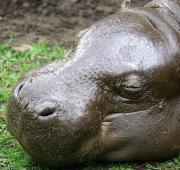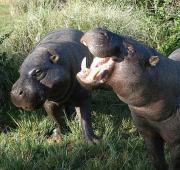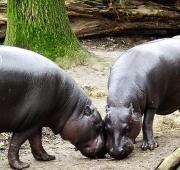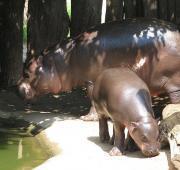 Pygmy Hippopotamus Classification and Evolution
Pygmy Hippopotamus Classification and EvolutionThe Pygmy Hippopotamus is a medium-sized herbivorous mammal that is found inhabiting the humid forests and swamps of West Africa. The Pygmy Hippopotamus is closely related to Africa's other Hippopotamus species, which is the Common Hippopotamus but is much smaller in size weighing around a fifth of it's enormous cousin's weight. Although the two species may look very similar there are actually a number of notable differences as the Pygmy Hippopotamus has a narrower mouth and sleeker body that helps it when moving quickly through the dense vegetation in the jungle. They also spend much less time in the water compared to the Common Hippopotamus and even rest in burrows in the vegetation on river banks. Unlike it's larger cousin though, the Pygmy Hippopotamus is a very rare animal that is severely threatened in it's remaining habitats by both hunting and habitat loss which appears to be hard to control in such an unregulated region.
 Pygmy Hippopotamus Anatomy and Appearance
Pygmy Hippopotamus Anatomy and Appearance
The Pygmy Hippopotamus has a long barrel-shaped body that is covered in slate-grey skin, which lightens towards the underside. The head of the Pygmy Hippopotamus is small in relation to it's body size and along with it's narrower mouth, makes it easier for them to run through the forest at speed. Due to the fact that the Pygmy Hippopotamus has evolved to being more land-dwelling than the larger Common Hippopotamus, they have a number of adaptations that aid them when in the dense forest. Although the Pygmy Hippopotamus is still semi-aquatic and will enter the water, they have fewer webbed toes than their cousin to help them move more effectively on land, and their eyes are also found on the sides of their head rather than on the top which again helps them to see more around them when they are amongst the trees. The Pygmy Hippopotamus also has long canines called tusks and although they are no-way near as impressive as those found in the mouth of the Common Hippopotamus, they are still used for intimidating rivals and intruders.

Although the Pygmy Hippopotamus would have once been found throughout more of it's current range, evidence suggests that the species has always been fairly rare. Pygmy Hippopotamuses are found in Liberia and Cote d'Ivoire in western Africa, along with there also being a few small and isolated populations in neighbouring Sierra Leone and Guinea. The Pygmy Hippopotamus inhabits areas of dense, lowland tropical forest and swampland, where it spends the majority of it's time foraging for food and resting on land. Despite the fact that Pygmy Hippopotamus populations have never been too numerous, their numbers have declined drastically particularity over recent years due to both hunting and habitat loss. The natural tropical forests that the Pygmy Hippopotamus inhabits are also home to rare and sought-after tropical timbers, with these areas therefore being subjected to high levels of illegal logging.

Unlike the larger and more sociable Common Hippopotamus, the Pygmy Hippopotamus does not live in herds and is in fact, largely solitary. Spending the hot days resting in the cool mud or in the burrow of another animal (such as an Otter) that it has enlarged, the Pygmy Hippopotamus spends comparatively little of it's time in water and tends to use it more as a refuge if it feels threatened. The Pygmy Hippopotamus is nocturnal and forages in the forest at night for a wide variety of plant matter and fallen fruits. Like their larger cousin, the Pygmy Hippopotamus follows well-trodden and marked paths between it's feeding and resting grounds and can dart through these tunnels at a remarkable pace if it feels in danger. Although Pygmy Hippopotamuses roam individual home ranges it is not uncommon for them to overlap those of others, and they are even known to tolerate the presence of other individuals in their territory.
Pygmy Hippopotamus Reproduction and Life Cycles
During the breeding season is one of the main times when male Pygmy Hippopotamuses become more aggressive and will bare their teeth and even fight with one another to earn the right to mate with the local females. After a gestation period that lasts for between six and seven months, the female Pygmy Hippopotamus gives birth to a single calf either in a den in the dense vegetation or in the water. Pygmy Hippopotamus calves weigh just under 6kg at birth and are fully weaned by the time they are eight months old, after which they begin to accompany their mother on foraging trips in the forest. Pygmy Hippopotamuses are relatively long-living animals that often reach older ages than the average Common Hippopotamus, particularity when kept in captivity.
Pygmy Hippopotamus Diet and Prey
The Pygmy Hippopotamus is a herbivorous animal which means that it only forages for and consumes different types of plant matter in order to acquire all of the nutrients that it needs to survive. Unlike the Common Hippopotamus that primarily (and almost only) feeds on grasses, the Pygmy Hippopotamus has a much more varied diet and consumes a wide range a plants and plant material throughout the forest. The Pygmy Hippopotamus forages under the cover of night eating grasses, ferns, leaves, shrubs and fruits that have fallen onto the forest floor from the branches above. The Pygmy Hippopotamus uses special tunnel through the dense jungle to move about most safely between it's resting and feeding grounds, ensuring that it can always have a good route of escape if danger approaches.
Pygmy Hippopotamus Predators and Threats
Due to the relatively large size of the Pygmy Hippopotamus it has few natural predators within it's native forest habitats with the exception of occasionally being stalked by a Leopard. The smaller and more vulnerable calves however, are preyed up by a number of jungle predators including other Wildcats and large Snakes such as Pythons, that are able easily ambush the unprotected young calf whilst it's mother is out foraging. The biggest threat to the remaining Pygmy Hippopotamus populations however is people, that have hunted them for their meat and have destroyed vast areas of their unique forest habitats. The often illegal deforestation of much of Africa's tropical rainforest is to provide rare, exotic woods for the timber industry and to clear land to make way for farming and agriculture.
Pygmy Hippopotamus Interesting Facts and Features
Due to the way that the skin of the Pygmy Hippopotamus is made up, the animal cannot sweat so when it comes into contact with air their skin easily dries up. Although this is not a problem in the water, to combat this the rest of the time a pink, oily substance is secreted through glands in the skin which is not only thought to prevent sunburn but also may have anti-bacterial properties that helps to keep wounds clean and prevent infection from the dirty water. The Pygmy Hippopotamus has slightly webbed feet, which help it when it is walking on muddy river bottoms and up slippery banks. Their webbed feet however do not prove to be a disadvantage on land, as the Pygmy Hippopotamus is capable of dashing through the well-marked tunnels in the vegetation at speeds of up to 30kph. Despite their appearance, both species of Hippopotamus are actually thought to be more closely related to Whales than they are to other even-toed mammals.
Pygmy Hippopotamus Relationship with Humans
The Pygmy Hippopotamus has fascinated people since the ancient Egyptian times but they have also been exploited by them. Although now legally protected, this rare and elusive animal is hunted for both it's teeth and it's meat, which despite not being closely related, is said to taste like pork. People however, have also had devastating affects on Pygmy Hippopotamus populations throughout much of their natural range with deforestation of their native habitats pushing these animals into ever smaller and more isolated regions. Logging for the timber industry and land clearance for agriculture is illegal in many parts of their natural range but is sadly too much of an area to patrol effectively so the practice continues still, with Pygmy Hippopotamuses also then being poached in the process.
Pygmy Hippopotamus Conservation Status and Life Today
Today, the Pygmy Hippopotamus is listed by the IUCN as an animal species that is Endangered in it's natural environment and is severely at risk from extinct in the near future. The sub-species of Pygmy Hippopotamus found in Niger is rarer still and listed by the Red List as being Critically Endangered, although many believe that it may sadly now be extinct. There are less than 3,000 Pygmy Hippopotamus individuals estimated to be left foraging in the hot, wet forests of western Africa today and numbers seem be declining still due to illegal hunting and habitat loss.

